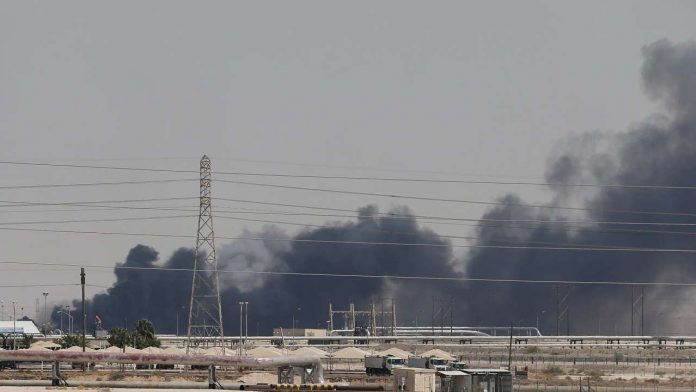Oil prices surged more than 15 percent to their highest level in nearly four months after an attack on Saudi Arabia’s oil facilities that knocked out more than five percent of global oil supply.
Brent crude futures jumped more than 19 percent to a session high of $71.95 a barrel at the market’s open. The Bloomberg news agency said it was the biggest rise in prices on record.
US crude futures surged more than 15 percent to a session high of $63.34 a barrel. Both benchmarks rose to their highest levels since May.
Prices were up about 12 percent by 2250 GMT, as gains were capped after US President Donald Trump said he authorized the release of oil from the US Strategic Petroleum Reserve (SPR) if needed in a quantity to be determined because of the attack on Saudi’s facilities.
State oil giant Saudi Aramco said the attack cut output by 5.7 million barrels per day, at a time when Aramco is trying to ready itself for what is expected to be the world’s largest share sale.
“I think the market is going to be in quite a bit of wait-and-watch mode, and of course, there’s going to be a lot of nervousness, and I expect a lot of volatility in trading as well,” Vandana Hari, founder and CEO of energy markets research firm Vanda Insights, told Al Jazeera.
Aramco gave no timeline for output resumption. A source close to the matter told the Reuters news agency the return to full oil capacity could take “weeks, not days.”
Saudi Arabia’s oil exports will continue as normal this week as the kingdom taps into stocks from its large storage facilities, an industry source briefed on the developments told Reuters on Sunday.
“The surge in prices is the natural knee-jerk reaction but the path ahead and ability to sustain at elevated levels remains dependent on the duration of the outage, the ability to meet export commitments through domestic drawdowns, demand elasticity at higher prices as well as government and agency policy,” said Michael Tran, managing director of energy strategy at RBC Capital Markets in New York.
“Even if the outage normalizes quickly, the threat of sidelining nearly six percent of global oil production is no longer a hypothetical, a black swan or a fat tail. Welcome back, risk premium.”
The attack on plants in the heartland of Saudi Arabia’s oil industry, including the world’s biggest petroleum-processing facility, came from the direction of Iran, and cruise missiles may have been used, according to a senior US official.
“Saudi authorities have claimed to control the fires, but this falls far short of extinguishing them,” said Abhishek Kumar, head of analytics at Interfax Energy in London.
“The damage to facilities at Abqaiq and Khurais appears to be extensive, and it may be weeks before oil supplies are normalised,” Kumar said.
Josh Young, portfolio manager at energy investment firm Bison Interests, told Al Jazeera’s Inside Story programme that the attack could also hurt the prospects for Saudi Aramco’s proposed giant share flotation.
“Given the geopolitical risk, and the actual physical security risk of their barrels being able to get produced and getting processed and getting sold, I mean one could argue that the likely valuation if they went public tomorrow, would be substantially lower than the number that they’re talking about,” Young said.
Saudi Arabia is set to become a significant buyer of refined products after attacks on Saturday, consultancy Energy Aspects said in a note.
State oil firm Saudi Aramco will likely buy significant quantities of gasoline, diesel and possibly fuel oil while cutting liquefied petroleum gas exports.
US gasoline futures jumped 11 percent, while US heating oil futures rose about 6.5 percent at the open.












